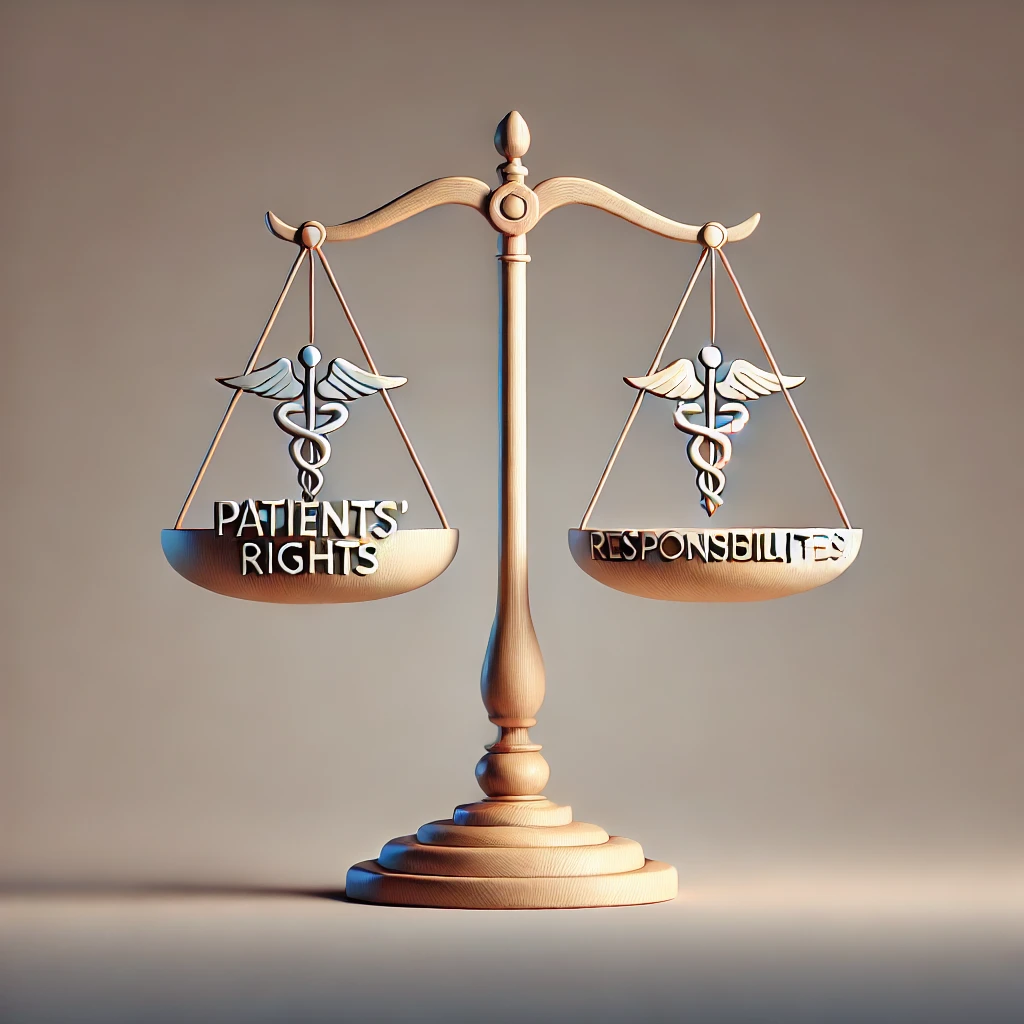Patients’ Rights and Responsibilities: What You Need to Know
Patients’ rights and responsibilities are the backbone of healthcare. From informed consent to confidentiality, understanding these rights and duties ensures better outcomes for everyone. Let’s break down what they really mean and how they empower both patients and providers.
Key Takeaways
- Patients’ rights empower individuals to make informed decisions about their care, including the right to refuse treatment.
- Honesty and openness are critical patient responsibilities that enable effective treatment and diagnosis.
- Providers must respect patient autonomy while creating safe spaces for open dialogue.
- Informed consent ensures patients understand their treatment plans, risks, and alternatives.
- Balancing rights and responsibilities requires empathy, trust, and effective communication.

What Are Patient Responsibilities?
First up: responsibilities. As a patient, you’ve got a big role to play in your care. Healthcare isn’t a one-way street—it’s a team effort.
Honesty Is Key
Patients have the responsibility to be completely honest with their caregivers. That means being truthful about medical history, current medications, lifestyle habits (yes, even the bad ones), and anything else that might impact their care.
But let’s be real for a second—this can be hard.
Think about it: how many people actually like admitting that they smoke, drink too much, or skip their workouts? These are loaded topics, and there’s so much stigma tied to them. Patients might hold back because they fear being judged or lectured by healthcare professionals.
Why It Matters
Here’s the thing: if you’re not honest with your doctor, they can’t help you properly. Imagine solving a puzzle without all the pieces—it’s basically impossible.
At the same time, though, healthcare providers have a responsibility, too. They need to create an environment where patients feel comfortable opening up. No one wants to feel like they’re being scolded or shamed, even if the advice is coming from a good place.
It’s a tricky balance, but it’s an essential part of making sure patients can meet their responsibilities.
What About Patients’ Rights?
Now, let’s flip the script and talk about rights.
This is a big one: Patients have the right to refuse treatment.
You heard that right. No matter how strongly a healthcare provider recommends something, the patient makes the ultimate decision.
Your Body, Your Choice
Let’s say a patient is given a grim diagnosis and a treatment plan that involves intense, aggressive therapies. It’s absolutely their right to say, “No thanks,” or to request a different approach—one that prioritizes quality of life over quantity.
And here’s the kicker: respecting that decision is the healthcare provider’s job.
Even if they don’t agree with the patient’s choice, they have to support it. That means helping the patient navigate their options, educating them on the potential consequences, and documenting everything to ensure transparency.
Why Patients Forget Their Rights
A lot of patients don’t realize they have this level of control. Why? Because they’re often pressured by healthcare providers, family, or society to “do whatever it takes.”
But here’s the reality: just because a treatment exists doesn’t mean it’s the right choice for everyone. Patients need to feel empowered to make the best decisions—even if that means going against the grain.
How Rights and Responsibilities Work Together
Here’s where things get interesting: patients’ rights and responsibilities are two sides of the same coin.
For a healthcare provider to respect a patient’s rights, the patient needs to meet their responsibilities. That means being honest about their health, goals, and concerns. In turn, the provider can give the best possible advice and support.
At the same time, patients need to feel confident in their rights to fulfill their responsibilities. Knowing they have the final say can make them more willing to open up and participate fully in their care.
Thoughts on Empathy
Whether you’re a patient or a healthcare provider, one thing is clear: empathy is everything.
Healthcare isn’t just about facts and treatments—it’s about people.
As a healthcare provider, your role isn’t just to educate—it’s to connect. Patients aren’t robots; they’re human beings with fears, hopes, and preferences. The best care happens when those things are acknowledged and respected.
Patient’s Responsibilities: Getting Honest in the Exam Room
It’s one thing to say, “Be honest with your healthcare provider.” But how does that play out in real life? Here are some common examples:
1. The Truth About Substance Use
It’s not uncommon for patients to underreport—or flat-out deny—substance use. Whether it’s smoking, drinking, or recreational drugs, these are taboo topics for a lot of people.
The Problem?
Healthcare providers rely on accurate information to make safe recommendations. For example:
- A doctor might prescribe a medication that interacts dangerously with alcohol if the patient doesn’t disclose their drinking habits.
- A smoker who keeps quiet about their habit might miss out on critical screenings for conditions like lung cancer or COPD.
Why Patients Hold Back
Here’s the truth: nobody likes feeling judged. Maybe they’ve had a bad experience with a provider lecturing them in the past. Or maybe they’re afraid of how the information might affect their care.
How Providers Can Help
This is where approach matters. Providers can frame questions in a way that feels less accusatory. Instead of asking, “Do you smoke?” they can say:
“Many of my patients use tobacco products—whether it’s regularly or just socially. Can you share if that applies to you?”
It’s all about creating a space where patients feel safe to be honest.
2. Medication Confessions
Patients often forget—or intentionally omit—details about over-the-counter medications, supplements, or even prescriptions they’re taking.
Why It Matters
Certain supplements (we’re looking at you, St. John’s Wort) can interact with prescription meds in dangerous ways. Forgetting to mention that nightly melatonin habit or the occasional aspirin can lead to serious complications.
Providers can help by asking targeted follow-ups:
- “Are you taking any vitamins or herbal supplements?”
- “What about pain relievers, like ibuprofen or acetaminophen?”
3. Downplaying Symptoms
Patients sometimes downplay symptoms because they don’t want to seem dramatic—or because they’re afraid of bad news.
- That chest pain that “only happens when I work out”? Might actually be a heart issue.
- That “occasional” dizziness? Could be a sign of a larger neurological condition.
As a provider, it’s crucial to explain that no detail is too small. Symptoms are pieces of a puzzle, and every one matters.
Patients’ Rights: Navigating Tough Choices
Let’s pivot back to rights. The concept of patients’ rights sounds great on paper, but what does it actually look like when a patient makes a decision their provider doesn’t agree with?
1. Refusing Treatment: The Gray Area
Let’s say a patient refuses chemotherapy for advanced cancer. As a healthcare provider, your gut instinct might be to push back. After all, you want to give them the best shot at survival, right?
But here’s the thing: It’s their body, their life, their choice.
How to Handle It
Respecting a patient’s right to refuse doesn’t mean throwing in the towel. It means:
- Explaining all the options clearly and without bias.
- Answering questions honestly, even if the answers are tough.
- Documenting everything, so it’s clear the patient made an informed decision.
A great way to phrase this is:
“My goal is to make sure you fully understand your options, the potential outcomes, and the risks involved. Ultimately, the choice is yours, and I’m here to support you no matter what.”
2. Alternative Treatments: The “Unconventional” Route
Now, imagine a patient who wants to try an alternative treatment—one that isn’t backed by solid evidence.
For example:
- A patient with chronic pain might want to skip traditional painkillers in favor of acupuncture.
- Someone with cancer might explore herbal remedies alongside (or instead of) chemo.
The Provider’s Role
Even if you don’t personally believe in the alternative option, your job is to support the patient in a way that keeps them safe.
You might say:
“I understand why this treatment appeals to you. While there isn’t strong evidence to support it, let’s work together to monitor your progress and ensure your safety. If you’re open to it, we can also explore ways to combine this with evidence-based treatments.”
This approach respects their rights while still prioritizing their health.
3. End-of-Life Decisions
One of the most emotionally charged aspects of patients’ rights is end-of-life care.
Patients have the right to:
- Refuse life-sustaining treatments, like ventilators or feeding tubes.
- Choose palliative care over aggressive interventions.
As a provider, it can be heartbreaking to watch a patient opt out of treatments that might extend their life. But again, it’s their right.
Your role is to ensure they fully understand their decision:
- What the process will look like.
- How it might affect their quality of life.
- Any options for comfort care.
The Role of Communication
At the end of the day, patients’ rights and responsibilities are all about communication. Here’s a quick breakdown of how both parties can improve:
| Patients | Healthcare Providers |
|---|---|
| Be honest, even about tough topics. | Ask questions in a nonjudgmental way. |
| Share concerns or fears openly. | Create a safe space for discussion. |
| Educate yourself on your rights. | Respect patient autonomy, always. |
| Don’t be afraid to ask questions. | Explain options and risks thoroughly. |
Confidentiality for Minors: When Rights Get Complicated
Minors are a unique group in healthcare because their rights are often influenced (or limited) by their age and the involvement of parents or guardians.
1. The Basics of Confidentiality for Minors
In general, minors have the right to confidentiality when it comes to sensitive health issues, such as:
- Sexual health (e.g., contraception, STI testing).
- Mental health counseling.
- Substance abuse treatment.
This means that even though a parent or guardian is typically involved in their care, the minor has the right to certain privacy protections.
The Challenge for Providers
Providers often walk a fine line when treating minors:
- On one hand, they must respect the minor’s right to confidentiality.
- On the other hand, they may have a legal obligation to inform parents or guardians in certain situations (e.g., when the minor’s safety is at risk).
2. When Confidentiality Gets Broken
There are certain circumstances where a provider is required to break confidentiality, even for an adult patient:
- Imminent harm: If the patient poses a risk to themselves or others.
- Mandatory reporting: In cases of abuse, neglect, or certain infectious diseases.
For minors, this can include notifying parents about situations like severe mental health crises or dangerous behaviors.
A Note for Providers
Communication is critical. If confidentiality must be broken, it’s best to explain the situation to the patient first. Let them know what will be shared, why, and how it will be handled. This preserves trust as much as possible.

Legal Implications of Patient Decisions
The legal side of healthcare is where patients’ rights and responsibilities take center stage. Let’s explore a couple of key examples:
1. Informed Consent
Patients have the right to make their own healthcare decisions—but only if those decisions are made with informed consent.
What Is Informed Consent?
It’s the process of ensuring the patient fully understands:
- The nature of the proposed treatment.
- Potential risks and benefits.
- Alternative options.
If a provider skips this step, it can lead to serious legal consequences.
2. Refusal of Treatment and Documentation
When a patient refuses treatment, healthcare providers must respect their decision—but they also need to protect themselves legally.
Why Documentation Matters
Providers must document everything:
- The advice and recommendations given.
- The patient’s decision to refuse treatment.
- A clear statement that the patient understood the potential consequences of their choice.
This documentation ensures that if a patient later claims they “weren’t informed,” the provider has proof to the contrary.
Patients’ Rights, Responsibilities, and Healthcare Professionals
At the end of the day, this entire discussion boils down to one key idea: mutual respect.
Healthcare works best when patients and providers approach the relationship as a partnership:
- Patients must take ownership of their responsibilities by being honest, informed, and engaged.
- Providers must honor patients’ rights while offering support, empathy, and clear communication.
FAQ: Patients’ Rights and Responsibilities
Here’s a quick and clear FAQ to address some of the most common questions about patients’ rights and responsibilities.
What are patients’ rights?
Patients’ rights are the protections and guarantees provided to anyone receiving medical care. They include the right to:
- Be treated with respect and dignity.
- Make decisions about your healthcare.
- Refuse treatment if you choose.
- Have your personal health information kept private.
- Receive clear explanations about your condition and treatment options.
What are patients’ responsibilities?
Patients have the responsibility to ensure they receive the best care possible. These include:
- Being honest about your medical history, medications, and symptoms.
- Following the treatment plan, you agree to or discuss alternatives.
- Asking questions when you don’t understand something.
- Respecting healthcare staff and other patients.
- Providing accurate insurance and billing information.
Can I refuse the treatment recommended by my healthcare provider?
Yes, you have the right to refuse treatment—even if your provider strongly recommends it. However, your healthcare provider will explain the risks and potential consequences of refusing treatment, and they are required to document your decision.
What happens if a patient isn’t honest with their healthcare provider?
If a patient withholds important information—like medication use, symptoms, or lifestyle habits—it can lead to misdiagnosis or inappropriate treatments. For example, not disclosing a smoking habit could lead to missing critical screenings for lung health. Being open and honest is vital for your safety and effective care.
What does “informed consent” mean?
Informed consent means that your healthcare provider must:
- Explain the proposed treatment, including its risks and benefits.
- Provide alternative options.
- Ensure you understand your choices.
You must voluntarily agree to the treatment. Without this process, a provider cannot legally or ethically proceed.
Can a minor make their own medical decisions?
It depends on the situation and the laws in the state or country. In some cases, minors can make decisions about sensitive issues like reproductive health, mental health, or substance abuse treatment without parental consent. However, in other cases, parental involvement is required.
When can a healthcare provider break patient confidentiality?
Healthcare providers can break confidentiality only in specific circumstances, such as:
- If a patient is a danger to themselves or others.
- If there is suspected abuse or neglect (especially with minors).
- In cases of certain infectious diseases, they must be reported to public health authorities.
Can I get a second opinion if I don’t agree with my provider’s recommendations?
Absolutely. Patients have the right to seek a second opinion if they are unsure or uncomfortable with a diagnosis or treatment plan. It’s a good way to ensure you’re making the best decision for your health.
How do I file a complaint if I believe my rights as a patient have been violated?
If you feel your rights have been violated, you can:
- Speak directly to the healthcare provider or facility involved.
- File a formal complaint with the hospital or clinic’s patient relations department.
- Contact your state’s medical board or health department.
- Report violations of HIPAA (patient confidentiality) to the U.S. Department of Health and Human Services.
What should I do if I don’t understand my treatment plan?
You have the responsibility—and the right—to ask questions. Tell your provider you need clarification. You can ask things like:
- “Can you explain this in simpler terms?”
- “What are the risks if I choose not to follow this treatment?”
- “Are there alternative options available?”
A good provider will take the time to ensure you fully understand.
Do patients have the right to choose alternative treatments?
Yes, patients can choose alternative treatments, but healthcare providers will likely discuss the evidence (or lack thereof) supporting those treatments. Providers are also responsible for ensuring the patient understands the risks of skipping evidence-based care in favor of alternatives.
How can patients and providers build better communication?
Great communication is a two-way street.
- Patients can help by being honest, asking questions, and sharing concerns.
- Providers should ask open-ended questions, avoid judgment, and explain things clearly.
Empathy and mutual respect are key to making the patient-provider relationship work.
Closing Thoughts
The balance between patients’ rights and responsibilities is a cornerstone of modern healthcare. Whether you’re a patient making a difficult decision or a healthcare provider navigating a challenging situation, remember that every interaction is an opportunity to build trust and understanding.
Let this be your reminder: healthcare isn’t just about medicine—it’s about people.
If you enjoyed this post, share it with someone who might benefit from it!
